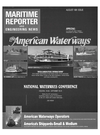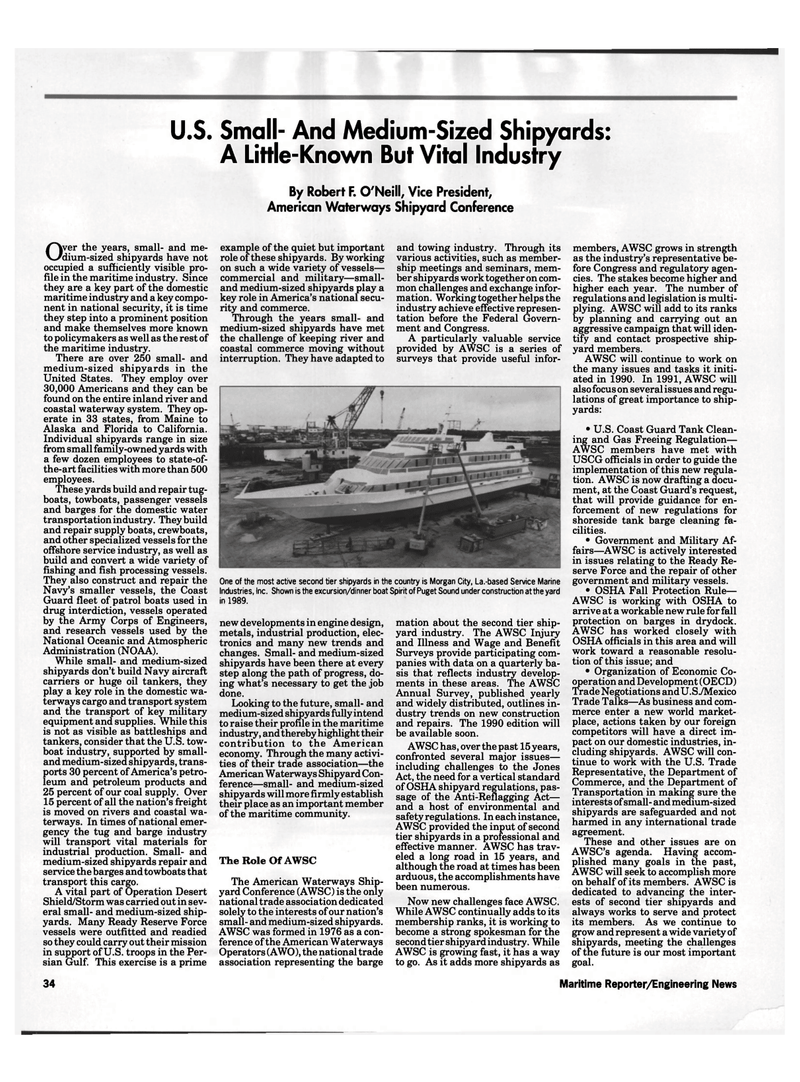
Page 32: of Maritime Reporter Magazine (August 1991)
Read this page in Pdf, Flash or Html5 edition of August 1991 Maritime Reporter Magazine
U.S. Small- And Medium-Sized Shipyards:
A Little-Known But Vital Industry
By Robert F. O'Neill, Vice President,
American Waterways Shipyard Conference
Oyer the years, small- and me-dium-sized shipyards have not occupied a sufficiently visible pro- file in the maritime industry. Since they are a key part of the domestic maritime industry and a key compo- nent in national security, it is time they step into a prominent position and make themselves more known to policymakers as well as the rest of the maritime industry.
There are over 250 small- and medium-sized shipyards in the
United States. They employ over 30,000 Americans and they can be found on the entire inland river and coastal waterway system. They op- erate in 33 states, from Maine to
Alaska and Florida to California.
Individual shipyards range in size from small family-owned yards with a few dozen employees to state-of- the-art facilities with more than 500 employees.
These yards build and repair tug- boats, towboats, passenger vessels and barges for the domestic water transportation industry. They build and repair supply boats, crewboats, and other specialized vessels for the offshore service industry, as well as build and convert a wide variety of fishing and fish processing vessels.
They also construct and repair the
Navy's smaller vessels, the Coast
Guard fleet of patrol boats used in drug interdiction, vessels operated by the Army Corps of Engineers, and research vessels used by the
National Oceanic and Atmospheric
Administration (NOAA).
While small- and medium-sized shipyards don't build Navy aircraft carriers or huge oil tankers, they play a key role in the domestic wa- terways cargo and transport system and the transport of key military equipment and supplies. While this is not as visible as battleships and tankers, consider that the U.S. tow- boat industry, supported by small- and medium-sized shipyards, trans- ports 30 percent of America's petro- leum and petroleum products and 25 percent of our coal supply. Over 15 percent of all the nation's freight is moved on rivers and coastal wa- terways. In times of national emer- gency the tug and barge industry will transport vital materials for industrial production. Small- and medium-sized shipyards repair and service the barges and towboats that transport this cargo.
A vital part of Operation Desert
Shield/Storm was carried out in sev- eral small- and medium-sized ship- yards. Many Ready Reserve Force vessels were outfitted and readied so they could carry out their mission in support of U.S. troops in the Per- sian Gulf. This exercise is a prime example of the quiet but important role of these shipyards. By working on such a wide variety of vessels— commercial and military—small- and medium-sized shipyards play a key role in America's national secu- rity and commerce.
Through the years small- and medium-sized shipyards have met the challenge of keeping river and coastal commerce moving without interruption. They have adapted to and towing industry. Through its various activities, such as member- ship meetings and seminars, mem- ber shipyards work together on com- mon challenges and exchange infor- mation. Working together helps the industry achieve effective represen- tation before the Federal Govern- ment and Congress.
A particularly valuable service provided by AWSC is a series of surveys that provide useful infor-
One of the most active second tier shipyards in the country is Morgan City, La.-based Service Marine
Industries, Inc. Shown is the excursion/dinner boat Spirit of Puget Sound under construction at the yard in 1989. new developments in engine design, metals, industrial production, elec- tronics and many new trends and changes. Small- and medium-sized shipyards have been there at every step along the path of progress, do- ing what's necessary to get the job done.
Looking to the future, small- and medium-sized shipyards fully intend to raise their profile in the maritime industry, and thereby highlight their contribution to the American economy. Through the many activi- ties of their trade association—the
American Waterways Shipyard Con- ference—small- and medium-sized shipyards will more firmly establish their place as an important member of the maritime community.
The Role Of AWSC
The American Waterways Ship- yard Conference (AWSC) is the only national trade association dedicated solely to the interests of our nation's small- and medium-sized shipyards.
AWSC was formed in 1976 as a con- ference of the American Waterways
Operators (AWO), the national trade association representing the barge mation about the second tier ship- yard industry. The AWSC Injury and Illness and Wage and Benefit
Surveys provide participating com- panies with data on a quarterly ba- sis that reflects industry develop- ments in these areas. The AWSC
Annual Survey, published yearly and widely distributed, outlines in- dustry trends on new construction and repairs. The 1990 edition will be available soon.
AWSC has, over the past 15 years, confronted several major issues— including challenges to the Jones
Act, the need for a vertical standard of OSHA shipyard regulations, pas- sage of the Anti-Reflagging Act— and a host of environmental and safety regulations. In each instance,
AWSC provided the input of second tier shipyards in a professional and effective manner. AWSC has trav- eled a long road in 15 years, and although the road at times has been arduous, the accomplishments have been numerous.
Now new challenges face AWSC.
While AWSC continually adds to its membership ranks, it is working to become a strong spokesman for the second tier shipyard industry. While
AWSC is growing fast, it has a way to go. As it adds more shipyards as members, AWSC grows in strength as the industry's representative be- fore Congress and regulatory agen- cies. The stakes become higher and higher each year. The number of regulations and legislation is multi- plying. AWSC will add to its ranks by planning and carrying out an aggressive campaign that will iden- tify and contact prospective ship- yard members.
AWSC will continue to work on the many issues and tasks it initi- ated in 1990. In 1991, AWSC will also focus on several issues and regu- lations of great importance to ship- yards: • U.S. Coast Guard Tank Clean- ing and Gas Freeing Regulation—
AWSC members have met with
USCG officials in order to guide the implementation of this new regula- tion. AWSC is now drafting a docu- ment, at the Coast Guard's request, that will provide guidance for en- forcement of new regulations for shoreside tank barge cleaning fa- cilities. • Government and Military Af- fairs—AWSC is actively interested in issues relating to the Ready Re- serve Force and the repair of other government and military vessels. • OSHA Fall Protection Rule—
AWSC is working with OSHA to arrive at a workable new rule for fall protection on barges in drydock.
AWSC has worked closely with
OSHA officials in this area and will work toward a reasonable resolu- tion of this issue; and • Organization of Economic Co- operation and Development (OECD)
Trade Negotiations andU.S./Mexico
Trade Talks—As business and com- merce enter a new world market- place, actions taken by our foreign competitors will have a direct im- pact on our domestic industries, in- cluding shipyards. AWSC will con- tinue to work with the U.S. Trade
Representative, the Department of
Commerce, and the Department of
Transportation in making sure the interests of small- and medium-sized shipyards are safeguarded and not harmed in any international trade agreement.
These and other issues are on
AWSC's agenda. Having accom- plished many goals in the past,
AWSC will seek to accomplish more on behalf of its members. AWSC is dedicated to advancing the inter- ests of second tier shipyards and always works to serve and protect its members. As we continue to grow and represent a wide variety of shipyards, meeting the challenges of the future is our most important goal. 34 Maritime Reporter/Engineering News

 31
31

 33
33
